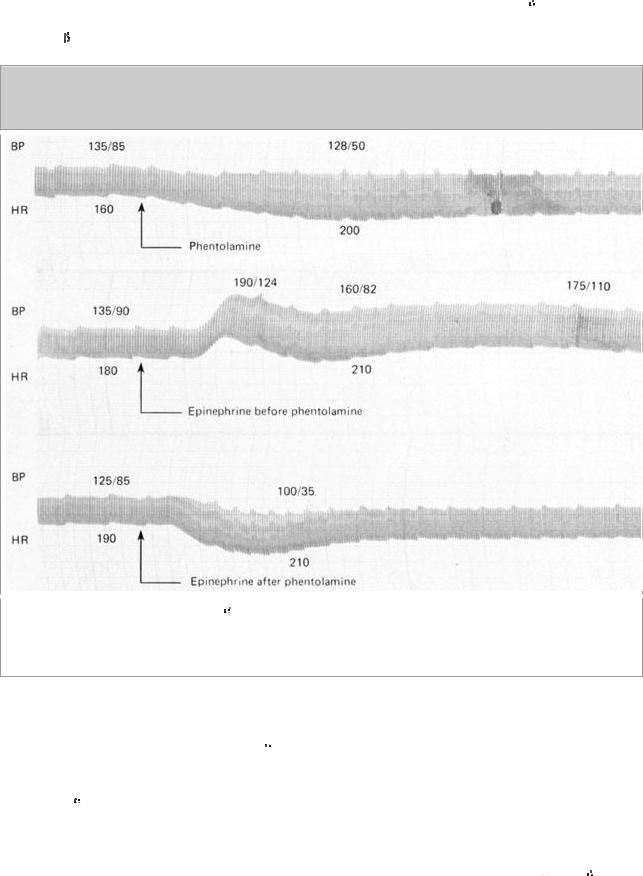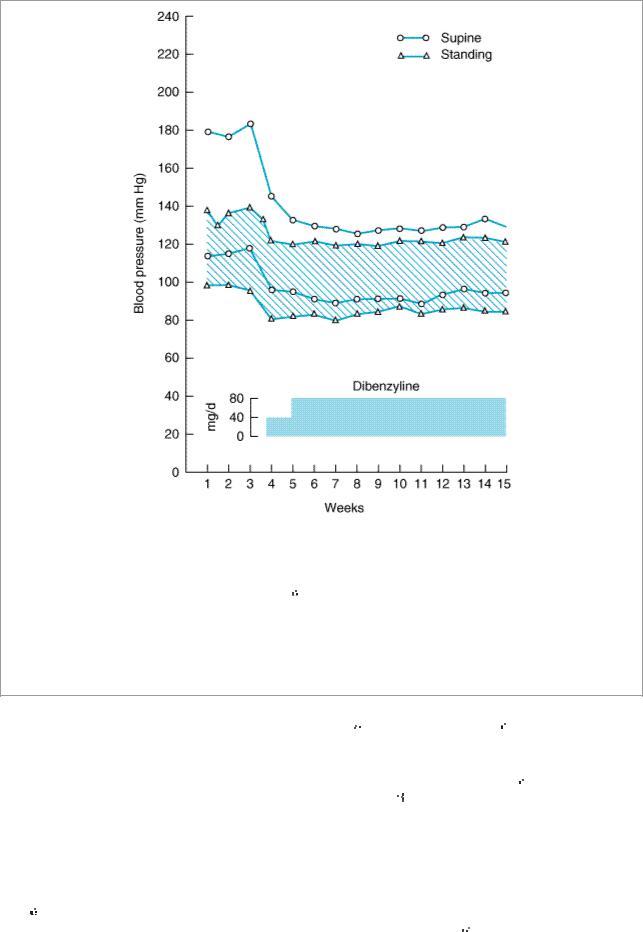
Книги фарма 2 / Bertram G. Katzung-Basic & Clinical Pharmacology(9th Edition)
.pdf
Dose-response curves to norepinephrine in the presence of two different 
 -adrenoceptor-blocking drugs. The tension produced in isolated strips of cat spleen, a tissue rich in
-adrenoceptor-blocking drugs. The tension produced in isolated strips of cat spleen, a tissue rich in 
 receptors, was measured in response to graded doses of norepinephrine. Left: Tolazoline, a reversible blocker, shifted the curve to the right without decreasing the maximum response when present at concentrations of 10 and 20 mol/L. Right: Dibenamine, an analog of phenoxybenzamine and irreversible in its action, reduced the maximum response attainable at both concentrations tested. (Modified and reproduced, with permission, from Bickerton RK: The response of isolated strips of cat spleen to sympathomimetic drugs and their antagonists. J Pharmacol Exp Ther 1963;142:99.)
receptors, was measured in response to graded doses of norepinephrine. Left: Tolazoline, a reversible blocker, shifted the curve to the right without decreasing the maximum response when present at concentrations of 10 and 20 mol/L. Right: Dibenamine, an analog of phenoxybenzamine and irreversible in its action, reduced the maximum response attainable at both concentrations tested. (Modified and reproduced, with permission, from Bickerton RK: The response of isolated strips of cat spleen to sympathomimetic drugs and their antagonists. J Pharmacol Exp Ther 1963;142:99.)
The duration of action of a reversible antagonist is largely dependent on the half-life of the drug in the body and the rate at which it dissociates from its receptor: The shorter the half-life of the drug in the body or of binding to its receptor, the less time it takes for the effects of the drug to dissipate. However, the effects of an irreversible antagonist may persist long after the drug has been cleared from the plasma. In the case of phenoxybenzamine, the restoration of tissue responsiveness after extensive 
 -receptor blockade is dependent on synthesis of new receptors, which may take several days. The rate of return of
-receptor blockade is dependent on synthesis of new receptors, which may take several days. The rate of return of 
 1 adrenoceptor drug effect may be particularly important in patients having a sudden cardiovascular event or who become candidates for urgent surgery.
1 adrenoceptor drug effect may be particularly important in patients having a sudden cardiovascular event or who become candidates for urgent surgery.
Pharmacologic Effects
Cardiovascular Effects
Because arteriolar and venous tone are determined to a large extent by 
 receptors on vascular smooth muscle,
receptors on vascular smooth muscle, 
 -receptor antagonist drugs cause a lowering of peripheral vascular resistance and blood pressure (Figure 10–3). These drugs can prevent the pressor effects of usual doses of
-receptor antagonist drugs cause a lowering of peripheral vascular resistance and blood pressure (Figure 10–3). These drugs can prevent the pressor effects of usual doses of 
 agonists; indeed, in the case of agonists with both
agonists; indeed, in the case of agonists with both 
 and
and  2 effects (eg, epinephrine), selective
2 effects (eg, epinephrine), selective 
 1 receptor antagonism may convert a pressor to a depressor response (Figure 10–3). This change in response is called epinephrine reversal; it illustrates how the activation of both
1 receptor antagonism may convert a pressor to a depressor response (Figure 10–3). This change in response is called epinephrine reversal; it illustrates how the activation of both 
 and
and 
 receptors in the same tissue may lead to opposite responses. Alpha-receptor antagonists may cause postural hypotension and reflex tachycardia. Postural hypotension is due to antagonism of sympathetic nervous system stimulation of
receptors in the same tissue may lead to opposite responses. Alpha-receptor antagonists may cause postural hypotension and reflex tachycardia. Postural hypotension is due to antagonism of sympathetic nervous system stimulation of 
 1 receptors in venous smooth muscle; contraction of veins is an
1 receptors in venous smooth muscle; contraction of veins is an

important component of the capacity to maintain blood pressure in the upright position since it decreases venous pooling in the periphery. Constriction of arterioles in the legs may also contribute to the postural response. Tachycardia may be more marked with agents that block 
 2-presynaptic receptors in the heart (Table 10–1), since the augmented release of norepinephrine will further stimulate
2-presynaptic receptors in the heart (Table 10–1), since the augmented release of norepinephrine will further stimulate 
 receptors in the heart.
receptors in the heart.
Figure 10–3.
Top: Effects of phentolamine, an 
 receptor-blocking drug, on blood pressure in an anesthetized dog. Epinephrine reversal is demonstrated by tracings showing the response to epinephrine before (middle) and after (bottom) phentolamine. All drugs given intravenously. (BP, blood pressure; HR, heart rate.)
receptor-blocking drug, on blood pressure in an anesthetized dog. Epinephrine reversal is demonstrated by tracings showing the response to epinephrine before (middle) and after (bottom) phentolamine. All drugs given intravenously. (BP, blood pressure; HR, heart rate.)
Other Effects
Minor effects that signal the blockade of  receptors in other tissues include miosis and nasal stuffiness. Alpha1-receptor blockade of the base of the bladder and the prostate is associated with decreased resistance to the flow of urine. Individual agents may have other important effects in addition to
receptors in other tissues include miosis and nasal stuffiness. Alpha1-receptor blockade of the base of the bladder and the prostate is associated with decreased resistance to the flow of urine. Individual agents may have other important effects in addition to 
 -receptor antagonism (see below).
-receptor antagonism (see below).
Specific Agents
Phentolamine, an imidazoline derivative, is a potent competitive antagonist at both 
 1 and
1 and 
 2 receptors (Table 10–1). Phentolamine causes a reduction in peripheral resistance through blockade
2 receptors (Table 10–1). Phentolamine causes a reduction in peripheral resistance through blockade

of 
 1 receptors and possibly
1 receptors and possibly 
 2 receptors on vascular smooth muscle. The cardiac stimulation induced by phentolamine is due to sympathetic stimulation of the heart resulting from baroreflex mechanisms. Furthermore, since phentolamine potently blocks
2 receptors on vascular smooth muscle. The cardiac stimulation induced by phentolamine is due to sympathetic stimulation of the heart resulting from baroreflex mechanisms. Furthermore, since phentolamine potently blocks 
 2 receptors, antagonism of presynaptic
2 receptors, antagonism of presynaptic 
 2 receptors may lead to enhanced release of norepinephrine from sympathetic nerves. Enhanced norepinephrine release may contribute to cardiac stimulation via unblocked
2 receptors may lead to enhanced release of norepinephrine from sympathetic nerves. Enhanced norepinephrine release may contribute to cardiac stimulation via unblocked  adrenoceptors, especially after intravenous injection. In addition to being an
adrenoceptors, especially after intravenous injection. In addition to being an 
 1- and
1- and 
 2-receptor antagonist, phentolamine also inhibits responses to serotonin and may be an agonist at muscarinic and H1 and H2 histamine receptors. Consequently, phentolamine has multiple potential actions, though it is not clear which if any of these are clinically significant.
2-receptor antagonist, phentolamine also inhibits responses to serotonin and may be an agonist at muscarinic and H1 and H2 histamine receptors. Consequently, phentolamine has multiple potential actions, though it is not clear which if any of these are clinically significant.
Table 10–1. Relative Selectivity of Antagonists for Adrenoceptors.
|
Receptor Affinity |
|||
|
|
|
|
|
Antagonists |
|
|
|
|
|
|
|
|
|
Prazosin, terazosin, doxazosin |
1 |
>>>> |
2 |
|
|
|
|
|
|
|
|
|
|
|
Phenoxybenzamine |
1 |
> 2 |
|
|
|
|
|
|
|
|
|
|
||
Phentolamine |
1 |
= alpha;2 |
||
|
|
|
|
|
|
|
|
|
|
Rauwolscine, yohimbine, tolazoline |
2 |
>>> |
1 |
|
|
|
|
|
|
|
|
|
|
|
Mixed antagonists |
|
|
|
|
|
|
|
|
|
Labetalol, carvedilol |
1 |
= |
2 |
1 > 2 |
|
|
|
|
|
|
|
|
|
|
Antagonists |
|
|
|
|
|
|
|
|
|
Metoprololol, acebutolol, alprenolol, atenolol, betaxolol, celiprolol, esmolol |
1 |
>>> |
2 |
|
|
|
|
|
|
|
|
|
|
|
Propranolol, carteolol, penbutolol, pindolol, timolol |
1 |
= |
2 |
|
|
|
|
|
|
|
|
|
||
Butoxamine |
2 |
>>> 1 |
||
|
|
|
|
|
|
|
|
|
|
Phentolamine has limited absorption after oral administration. Its pharmacokinetic properties are not well known; it may reach peak concentrations within an hour after oral administration and has a half-life of about 5–7 hours. The principal adverse effects are related to cardiac stimulation, which may cause severe tachycardia, arrhythmias, and myocardial ischemia, especially after intravenous administration. With oral administration, adverse effects include tachycardia, nasal congestion, and headache.
Phentolamine has been used in the treatment of pheochromocytoma—especially intraoperatively— as well as for male erectile dysfunction by injection intracavernosally and when taken orally (see below).

Tolazoline is similar to phentolamine. Tolazoline has very limited clinical application in the treatment of pulmonary hypertension in newborn infants with respiratory distress syndrome. Its efficacy in this condition is doubtful, and the drug is rarely used.
Ergot derivatives—eg, ergotamine, dihydroergotamine—cause reversible 
 -receptor blockade. However, most of the clinically significant effects of these drugs are the result of other actions; eg, ergotamine probably acts at serotonin receptors in the treatment of migraine (Chapter 16: Histamine, Serotonin, & the Ergot Alkaloids).
-receptor blockade. However, most of the clinically significant effects of these drugs are the result of other actions; eg, ergotamine probably acts at serotonin receptors in the treatment of migraine (Chapter 16: Histamine, Serotonin, & the Ergot Alkaloids).
Phenoxybenzamine binds covalently to 
 receptors, causing irreversible blockade of long duration (14–48 hours or longer). It is somewhat selective for
receptors, causing irreversible blockade of long duration (14–48 hours or longer). It is somewhat selective for 
 1 receptors but less so than prazosin (Table 10–1). The drug also inhibits reuptake of released norepinephrine by presynaptic adrenergic nerve terminals. Phenoxybenzamine blocks histamine (H1), acetylcholine, and serotonin receptors as well as
1 receptors but less so than prazosin (Table 10–1). The drug also inhibits reuptake of released norepinephrine by presynaptic adrenergic nerve terminals. Phenoxybenzamine blocks histamine (H1), acetylcholine, and serotonin receptors as well as 
 receptors (see Chapter 16: Histamine, Serotonin, & the Ergot Alkaloids).
receptors (see Chapter 16: Histamine, Serotonin, & the Ergot Alkaloids).
The pharmacologic actions of phenoxybenzamine are primarily related to antagonism of  -receptor- mediated events. Most importantly, phenoxybenzamine attenuates catecholamine-induced vasoconstriction. While phenoxybenzamine causes relatively little fall in blood pressure in normal supine individuals, it reduces blood pressure when sympathetic tone is high, eg, as a result of upright posture or because of reduced blood volume. Cardiac output may be increased because of reflex effects and because of some blockade of presynaptic
-receptor- mediated events. Most importantly, phenoxybenzamine attenuates catecholamine-induced vasoconstriction. While phenoxybenzamine causes relatively little fall in blood pressure in normal supine individuals, it reduces blood pressure when sympathetic tone is high, eg, as a result of upright posture or because of reduced blood volume. Cardiac output may be increased because of reflex effects and because of some blockade of presynaptic 
 2 receptors in cardiac sympathetic nerves.
2 receptors in cardiac sympathetic nerves.
Phenoxybenzamine is absorbed after oral administration, although bioavailability is low and its kinetic properties are not well known. The drug is usually given orally, starting with low doses of 10–20 mg/d and progressively increasing the dose until the desired effect is achieved. Less than 100 mg/d is usually sufficient to achieve adequate  -receptor blockade. The major use of phenoxybenzamine is in the treatment of pheochromocytoma (see below).
-receptor blockade. The major use of phenoxybenzamine is in the treatment of pheochromocytoma (see below).
Many of the adverse effects of phenoxybenzamine derive from its 
 -receptor-blocking action; the most important are postural hypotension and tachycardia. Nasal stuffiness and inhibition of ejaculation also occur. Since phenoxybenzamine enters the central nervous system, it may cause less specific effects, including fatigue, sedation, and nausea. Since phenoxybenzamine is an alkylating agent, it may have other adverse effects that have not yet been characterized. Phenoxybenzamine causes tumors in animals, but the clinical implications of this observation are unknown.
-receptor-blocking action; the most important are postural hypotension and tachycardia. Nasal stuffiness and inhibition of ejaculation also occur. Since phenoxybenzamine enters the central nervous system, it may cause less specific effects, including fatigue, sedation, and nausea. Since phenoxybenzamine is an alkylating agent, it may have other adverse effects that have not yet been characterized. Phenoxybenzamine causes tumors in animals, but the clinical implications of this observation are unknown.
Prazosin is a piperazinyl quinazoline effective in the management of hypertension (see Chapter 11: Antihypertensive Agents). It is highly selective for 
 1 receptors, having relatively low affinity for
1 receptors, having relatively low affinity for 
 2 receptors (typically 1000-fold less potent). This may partially explain the relative absence of tachycardia seen with prazosin as compared to what is reported with phentolamine and phenoxybenzamine. Prazosin leads to relaxation of both arterial and venous smooth muscle due to blockade of
2 receptors (typically 1000-fold less potent). This may partially explain the relative absence of tachycardia seen with prazosin as compared to what is reported with phentolamine and phenoxybenzamine. Prazosin leads to relaxation of both arterial and venous smooth muscle due to blockade of 
 1 receptors. Prazosin is extensively metabolized in humans; because of metabolic degradation by the liver, only about 50% of the drug is available after oral administration. The halflife is normally about 3 hours.
1 receptors. Prazosin is extensively metabolized in humans; because of metabolic degradation by the liver, only about 50% of the drug is available after oral administration. The halflife is normally about 3 hours.
Terazosin is another reversible 
 1-selective antagonist that is effective in hypertension (Chapter 11: Antihypertensive Agents); it has also been approved for use in men with urinary symptoms due to benign prostatic hyperplasia (BPH). Terazosin has high bioavailability but is extensively metabolized in the liver, with only a small fraction of unchanged drug excreted in the urine. The half-life of terazosin is 9–12 hours.
1-selective antagonist that is effective in hypertension (Chapter 11: Antihypertensive Agents); it has also been approved for use in men with urinary symptoms due to benign prostatic hyperplasia (BPH). Terazosin has high bioavailability but is extensively metabolized in the liver, with only a small fraction of unchanged drug excreted in the urine. The half-life of terazosin is 9–12 hours.

Doxazosin is efficacious in the treatment of hypertension and BPH. It differs from prazosin and terazosin in having a longer half-life of about 22 hours. It has moderate bioavailability and is extensively metabolized, with very little parent drug excreted in urine or feces. Doxazosin has active metabolites, although their contribution to the drug's effects is probably small.
Tamsulosin is a competitive 
 1 antagonist with a structure quite different from that of most other
1 antagonist with a structure quite different from that of most other 
 1-receptor blockers. It has high bioavailability and a long half-life of 9–15 hours. It is metabolized extensively in the liver. Tamsulosin has higher affinity for
1-receptor blockers. It has high bioavailability and a long half-life of 9–15 hours. It is metabolized extensively in the liver. Tamsulosin has higher affinity for 
 1A and
1A and 
 1D receptors than for the
1D receptors than for the 
 1B subtype. The drug's efficacy in BPH suggests that the
1B subtype. The drug's efficacy in BPH suggests that the  1A subtype may be the most important
1A subtype may be the most important  subtype mediating prostate smooth muscle contraction. Evidence suggests that tamsulosin has relatively greater potency in inhibiting contraction in prostate smooth muscle versus vascular smooth muscle, compared with other
subtype mediating prostate smooth muscle contraction. Evidence suggests that tamsulosin has relatively greater potency in inhibiting contraction in prostate smooth muscle versus vascular smooth muscle, compared with other 
 1-selective antagonists, which have equal or greater effects in vascular smooth muscle. This finding suggests that
1-selective antagonists, which have equal or greater effects in vascular smooth muscle. This finding suggests that 
 1A receptors are less important in mediating contraction in human arteries and veins. Furthermore, compared with other antagonists, tamsulosin has less effect on standing blood pressure in patients. Nonetheless, caution is appropriate in using any
1A receptors are less important in mediating contraction in human arteries and veins. Furthermore, compared with other antagonists, tamsulosin has less effect on standing blood pressure in patients. Nonetheless, caution is appropriate in using any 
 antagonist in patients with diminished sympathetic nervous system function.
antagonist in patients with diminished sympathetic nervous system function.
Other Alpha-Adrenoceptor Antagonists
Alfuzosin is an 
 1-selective quinazoline derivative that has also been shown to be efficacious in BPH. It has a bioavailability of about 60%, is extensively metabolized, and has an elimination halflife of about 5 hours. This drug is not currently available in the USA. Indoramin is another
1-selective quinazoline derivative that has also been shown to be efficacious in BPH. It has a bioavailability of about 60%, is extensively metabolized, and has an elimination halflife of about 5 hours. This drug is not currently available in the USA. Indoramin is another 
 1- selective antagonist that also has efficacy as an antihypertensive. Urapidil is an
1- selective antagonist that also has efficacy as an antihypertensive. Urapidil is an 
 1 antagonist (its primary effect) that also has weak
1 antagonist (its primary effect) that also has weak 
 2-agonist and 5-HT1A-agonist actions and weak antagonist action at
2-agonist and 5-HT1A-agonist actions and weak antagonist action at  1 receptors. It is used in Europe as an antihypertensive agent and for benign prostatic hyperplasia. Labetalol has both
1 receptors. It is used in Europe as an antihypertensive agent and for benign prostatic hyperplasia. Labetalol has both  1-selective and
1-selective and 
 -antagonistic effects; it is discussed below. Neuroleptic drugs such as chlorpromazine and haloperidol are potent dopamine receptor antagonists but may also be antagonists at
-antagonistic effects; it is discussed below. Neuroleptic drugs such as chlorpromazine and haloperidol are potent dopamine receptor antagonists but may also be antagonists at 
 receptors. Their antagonism of
receptors. Their antagonism of  receptors probably contributes to some of their adverse effects, particularly hypotension. Similarly, the antidepressant trazodone has the capacity to block
receptors probably contributes to some of their adverse effects, particularly hypotension. Similarly, the antidepressant trazodone has the capacity to block 
 1 receptors.
1 receptors.
Yohimbine, an indole alkaloid, is an 
 2-selective antagonist. It has no established clinical role. Theoretically, it could be useful in autonomic insufficiency by promoting neurotransmitter release through blockade of presynaptic
2-selective antagonist. It has no established clinical role. Theoretically, it could be useful in autonomic insufficiency by promoting neurotransmitter release through blockade of presynaptic 
 2 receptors. It has been suggested that yohimbine improves male sexual function; however, evidence for this effect in humans is limited. Yohimbine can abruptly reverse the antihypertensive effects of an
2 receptors. It has been suggested that yohimbine improves male sexual function; however, evidence for this effect in humans is limited. Yohimbine can abruptly reverse the antihypertensive effects of an 
 2-adrenoceptor agonist such as clonidine—a potentially serious adverse drug interaction.
2-adrenoceptor agonist such as clonidine—a potentially serious adverse drug interaction.
Katzung PHARMACOLOGY, 9e > Section II. Autonomic Drugs > Chapter 10. Adrenoceptor Antagonist Drugs >
Clinical Pharmacology of the Alpha-Receptor-Blocking Drugs
Pheochromocytoma
The major clinical use of both phenoxybenzamine and phentolamine is in the management of pheochromocytoma. Pheochromocytoma is a tumor usually found in the adrenal medulla that releases a mixture of epinephrine and norepinephrine. Patients have many symptoms and signs of catecholamine excess, including intermittent or sustained hypertension, headaches, palpitations, and increased sweating.

The diagnosis of pheochromocytoma is usually made on the basis of chemical assay of circulating catecholamines and urinary excretion of catecholamine metabolites, especially 3-hydroxy-4- methoxymandelic acid, metanephrine, and normetanephrine. Measurement of plasma metanephrines has shown promise as an effective diagnostic tool. A variety of diagnostic techniques are available to localize a pheochromocytoma diagnosed biochemically, including CT and MRI scans as well as scanning with various radioisotopes.
Infusion of phentolamine was advocated in the past as a diagnostic test when pheochromocytoma was suspected, since patients with this tumor often manifest a greater drop in blood pressure in response to 
 -blocking drugs than do patients with primary hypertension. Provocative testing by infusion of histamine was occasionally used because this vasodilator drug may elicit a marked reflex rise in pressure in patients with pheochromocytoma. These tests are obsolete because measurement of circulating catecholamines and urinary catecholamines and their metabolites is a safer and far more reliable diagnostic approach.
-blocking drugs than do patients with primary hypertension. Provocative testing by infusion of histamine was occasionally used because this vasodilator drug may elicit a marked reflex rise in pressure in patients with pheochromocytoma. These tests are obsolete because measurement of circulating catecholamines and urinary catecholamines and their metabolites is a safer and far more reliable diagnostic approach.
Unavoidable release of stored catecholamines sometimes occurs during operative manipulation of pheochromocytoma; the resulting hypertension may be controlled with phentolamine or nitroprusside. Nitroprusside has many advantages, particularly since its effects can be more readily titrated and it has a shorter duration of action.
Alpha-receptor antagonists are most useful in the preoperative management of patients with pheochromocytoma (Figure 10–4). Administration of phenoxybenzamine in the preoperative period will help control hypertension and will tend to reverse chronic changes resulting from excessive catecholamine secretion such as plasma volume contraction, if present. Furthermore, the patient's operative course may be simplified. Oral doses of 10–20 mg/d may be increased at intervals of several days until hypertension is controlled. Some physicians give phenoxybenzamine to patients with pheochromocytoma for 1–3 weeks before surgery. Other surgeons prefer to operate on patients in the absence of treatment with phenoxybenzamine, counting on modern anesthetic techniques to control blood pressure and heart rate during surgery. Phenoxybenzamine may be very useful in the chronic treatment of inoperable or metastatic pheochromocytoma. Although there is less experience with alternative drugs, hypertension in patients with pheochromocytoma may also respond to reversible 
 1-selective antagonists or to conventional calcium channel antagonists. Beta-receptor antagonists may be required after
1-selective antagonists or to conventional calcium channel antagonists. Beta-receptor antagonists may be required after 
 -receptor blockade has been instituted to reverse the cardiac effects of excessive catecholamines. Beta antagonists should not be employed prior to establishing effective
-receptor blockade has been instituted to reverse the cardiac effects of excessive catecholamines. Beta antagonists should not be employed prior to establishing effective 
 -receptor blockade, since unopposed
-receptor blockade, since unopposed 
 -receptor blockade could theoretically cause blood pressure elevation from increased vasoconstriction.
-receptor blockade could theoretically cause blood pressure elevation from increased vasoconstriction.
Figure 10–4.

Effects of phenoxybenzamine (Dibenzyline) on blood pressure in a patient with pheochromocytoma. Dosage of the drug was begun in the third week as shown by the shaded bar. Supine systolic and diastolic pressures are indicated by the circles, the standing pressures by triangles and the hatched area. Note that the 
 -blocking drug dramatically reduced blood pressure. The reduction in orthostatic hypotension, which was marked before treatment, is probably due to normalization of blood volume, a variable that is sometimes markedly reduced in patients with long-standing pheochromocytoma-induced hypertension. (Redrawn and reproduced, with permission, from Engelman E, Sjoerdsma A: Chronic medical therapy for pheochromocytoma. Ann Intern Med 1961;61:229.)
-blocking drug dramatically reduced blood pressure. The reduction in orthostatic hypotension, which was marked before treatment, is probably due to normalization of blood volume, a variable that is sometimes markedly reduced in patients with long-standing pheochromocytoma-induced hypertension. (Redrawn and reproduced, with permission, from Engelman E, Sjoerdsma A: Chronic medical therapy for pheochromocytoma. Ann Intern Med 1961;61:229.)
Pheochromocytoma is rarely treated with metyrosine (
 -methyltyrosine), the
-methyltyrosine), the  -methyl analog of tyrosine. This agent is a competitive inhibitor of tyrosine hydroxylase and, in oral doses of 1–4 g/d, interferes with synthesis of dopamine (see Figure 6–5), thereby decreasing the amounts of norepinephrine and epinephrine secreted by the tumor. Metyrosine, while not an
-methyl analog of tyrosine. This agent is a competitive inhibitor of tyrosine hydroxylase and, in oral doses of 1–4 g/d, interferes with synthesis of dopamine (see Figure 6–5), thereby decreasing the amounts of norepinephrine and epinephrine secreted by the tumor. Metyrosine, while not an 
 -adrenoceptor antagonist, may act additively with phenoxybenzamine and a
-adrenoceptor antagonist, may act additively with phenoxybenzamine and a 
 -adrenoceptor antagonist in the treatment of pheochromocytoma. Metyrosine is especially useful in symptomatic patients with inoperable or metastatic pheochromocytoma.
-adrenoceptor antagonist in the treatment of pheochromocytoma. Metyrosine is especially useful in symptomatic patients with inoperable or metastatic pheochromocytoma.
Hypertensive Emergencies
The 
 -adrenoceptor antagonist drugs have limited application in the management of hypertensive emergencies, although labetalol has been used in this setting. In theory,
-adrenoceptor antagonist drugs have limited application in the management of hypertensive emergencies, although labetalol has been used in this setting. In theory, 
 -adrenoceptor antagonists
-adrenoceptor antagonists

are most useful when increased blood pressure reflects excess circulating concentrations of 
 agonists. In this circumstance, which may result from pheochromocytoma, overdosage of sympathomimetic drugs, or clonidine withdrawal, phentolamine can be used to control high blood pressure. However, other drugs are generally preferable (see Chapter 11: Antihypertensive Agents), since considerable experience is necessary to use phentolamine safely in these settings and few physicians have such experience.
agonists. In this circumstance, which may result from pheochromocytoma, overdosage of sympathomimetic drugs, or clonidine withdrawal, phentolamine can be used to control high blood pressure. However, other drugs are generally preferable (see Chapter 11: Antihypertensive Agents), since considerable experience is necessary to use phentolamine safely in these settings and few physicians have such experience.
Chronic Hypertension
Members of the prazosin family of 
 1-selective antagonists are efficacious drugs in the treatment of mild to moderate systemic hypertension. They are generally well tolerated by most patients. However, their efficacy in preventing heart failure when used as monotherapy for hypertension has been questioned. Their major adverse effect is postural hypotension, which may be severe after the first dose but is otherwise uncommon (see Chapter 11: Antihypertensive Agents). Nonselective
1-selective antagonists are efficacious drugs in the treatment of mild to moderate systemic hypertension. They are generally well tolerated by most patients. However, their efficacy in preventing heart failure when used as monotherapy for hypertension has been questioned. Their major adverse effect is postural hypotension, which may be severe after the first dose but is otherwise uncommon (see Chapter 11: Antihypertensive Agents). Nonselective  antagonists are not used in primary systemic hypertension. Prazosin and related drugs may also be associated with feelings of dizziness. This symptom may not be due to a fall in blood pressure, but postural changes in blood pressure should be checked routinely in any patient being treated for hypertension.
antagonists are not used in primary systemic hypertension. Prazosin and related drugs may also be associated with feelings of dizziness. This symptom may not be due to a fall in blood pressure, but postural changes in blood pressure should be checked routinely in any patient being treated for hypertension.
Interestingly, the use of 
 -adrenoceptor antagonists such as prazosin has been found to be associated with either no changes in plasma lipids or increased concentrations of HDL, which could be a favorable alteration. The mechanism for this effect is not known.
-adrenoceptor antagonists such as prazosin has been found to be associated with either no changes in plasma lipids or increased concentrations of HDL, which could be a favorable alteration. The mechanism for this effect is not known.
Peripheral Vascular Disease
Although 
 -receptor-blocking drugs have been tried in the treatment of peripheral vascular occlusive disease, there is no evidence that the effects are significant when morphologic changes limit flow in the vessels. Occasionally, individuals with Raynaud's phenomenon and other conditions involving excessive reversible vasospasm in the peripheral circulation do benefit from phentolamine, prazosin, or phenoxybenzamine, although calcium channel blockers may be preferable for many patients.
-receptor-blocking drugs have been tried in the treatment of peripheral vascular occlusive disease, there is no evidence that the effects are significant when morphologic changes limit flow in the vessels. Occasionally, individuals with Raynaud's phenomenon and other conditions involving excessive reversible vasospasm in the peripheral circulation do benefit from phentolamine, prazosin, or phenoxybenzamine, although calcium channel blockers may be preferable for many patients.
Local Vasoconstrictor Excess
Phentolamine has been used to reverse the intense local vasoconstriction caused by inadvertent infiltration of 
 agonists (eg, norepinephrine) into subcutaneous tissue during intended intravenous administration. The
agonists (eg, norepinephrine) into subcutaneous tissue during intended intravenous administration. The 
 antagonist is administered by local infiltration into the ischemic tissue.
antagonist is administered by local infiltration into the ischemic tissue.
Urinary Obstruction
Benign prostatic hyperplasia is a prevalent disorder in elderly men. A variety of surgical treatments are effective in relieving the urinary symptoms of BPH; however, drug therapy is efficacious in many patients. Alpha-receptor blockade was first found to be helpful in BPH using phenoxybenzamine in selected patients who were poor operative risks. The mechanism of action in improving urine flow involves partial reversal of smooth muscle contraction in the enlarged prostate and in the bladder base. It has been suggested that some 
 1-receptor antagonists may have additional effects on cells in the prostate that help improve symptoms.
1-receptor antagonists may have additional effects on cells in the prostate that help improve symptoms.
A number of well-controlled studies have demonstrated reproducible efficacy of several 
 1-receptor antagonists in patients with BPH—lasting for several years in many cases. Prazosin, doxazocin, and terazosin are efficacious. These drugs are particularly useful in patients who also have hypertension.
1-receptor antagonists in patients with BPH—lasting for several years in many cases. Prazosin, doxazocin, and terazosin are efficacious. These drugs are particularly useful in patients who also have hypertension.

Considerable interest has focused on which 
 1-receptor subtype is most important for smooth muscle contraction in the prostate: subtype-selective
1-receptor subtype is most important for smooth muscle contraction in the prostate: subtype-selective 
 1A-receptor antagonists might lead to improved efficacy and safety in treating this disease. As indicated above, tamsulosin is also efficacious in BPH and has little if any effect on blood pressure. This drug may be preferred in patients who have experienced postural hypotension with other
1A-receptor antagonists might lead to improved efficacy and safety in treating this disease. As indicated above, tamsulosin is also efficacious in BPH and has little if any effect on blood pressure. This drug may be preferred in patients who have experienced postural hypotension with other 
 1-receptor antagonists. Some evidence suggests that the efficacy of
1-receptor antagonists. Some evidence suggests that the efficacy of 
 1-receptor antagonists exceeds that of finasteride, the 5
1-receptor antagonists exceeds that of finasteride, the 5
 - reductase inhibitor (see Chapter 40: The Gonadal Hormones & Inhibitors).
- reductase inhibitor (see Chapter 40: The Gonadal Hormones & Inhibitors).
Erectile Dysfunction
A combination of the  -adrenoceptor antagonist phentolamine with the nonspecific vasodilator papaverine, when injected directly into the penis, may cause erections in men with sexual dysfunction. Fibrotic reactions may occur, especially with long-term administration. Systemic absorption may lead to orthostatic hypotension; priapism may require direct treatment with an
-adrenoceptor antagonist phentolamine with the nonspecific vasodilator papaverine, when injected directly into the penis, may cause erections in men with sexual dysfunction. Fibrotic reactions may occur, especially with long-term administration. Systemic absorption may lead to orthostatic hypotension; priapism may require direct treatment with an 
 - adrenoceptor agonist such as phenylephrine. Orally administered phentolamine is being investigated in patients with erectile dysfunction (and in women with disorders of arousal.) Alternative therapies include prostaglandins (see Chapter 18: The Eicosanoids: Prostaglandins, Thromboxanes, Leukotrienes, & Related Compounds), sildenafil, a cGMP phosphodiesterase inhibitor (see Chapter 12: Vasodilators & the Treatment of Angina Pectoris), and apomorphine.
- adrenoceptor agonist such as phenylephrine. Orally administered phentolamine is being investigated in patients with erectile dysfunction (and in women with disorders of arousal.) Alternative therapies include prostaglandins (see Chapter 18: The Eicosanoids: Prostaglandins, Thromboxanes, Leukotrienes, & Related Compounds), sildenafil, a cGMP phosphodiesterase inhibitor (see Chapter 12: Vasodilators & the Treatment of Angina Pectoris), and apomorphine.
Applications of Alpha2 Antagonists
Alpha2 antagonists have relatively little clinical usefulness. There has been experimental interest in the development of highly selective antagonists for use in Raynaud's phenomenon to inhibit smooth muscle contraction and in the treatment of type 2 diabetes (
 2 receptors inhibit insulin secretion) and psychiatric depression. It is not known to what extent the recognition of multiple subtypes of
2 receptors inhibit insulin secretion) and psychiatric depression. It is not known to what extent the recognition of multiple subtypes of 
 2 receptors will lead to development of clinically useful subtype-selective new drugs.
2 receptors will lead to development of clinically useful subtype-selective new drugs.
Katzung PHARMACOLOGY, 9e > Section II. Autonomic Drugs > Chapter 10. Adrenoceptor Antagonist Drugs >
Basic Pharmacology of the Beta-Receptor-Antagonist Drugs
Drugs in this category share the common feature of antagonizing the effects of catecholamines at  adrenoceptors. Beta-blocking drugs occupy
adrenoceptors. Beta-blocking drugs occupy  receptors and competitively reduce receptor occupancy by catecholamines and other
receptors and competitively reduce receptor occupancy by catecholamines and other  agonists. (A few members of this group, used only for experimental purposes, bind irreversibly to
agonists. (A few members of this group, used only for experimental purposes, bind irreversibly to 
 receptors.) Most
receptors.) Most 
 -blocking drugs in clinical use are pure antagonists; ie, the occupancy of a
-blocking drugs in clinical use are pure antagonists; ie, the occupancy of a 
 receptor by such a drug causes no activation of the receptor. However, some are partial agonists; ie, they cause partial activation of the receptor, albeit less than that caused by the full agonists epinephrine and isoproterenol. As described in Chapter 2: Drug Receptors & Pharmacodynamics, partial agonists inhibit the activation of
receptor by such a drug causes no activation of the receptor. However, some are partial agonists; ie, they cause partial activation of the receptor, albeit less than that caused by the full agonists epinephrine and isoproterenol. As described in Chapter 2: Drug Receptors & Pharmacodynamics, partial agonists inhibit the activation of  receptors in the presence of high catecholamine concentrations but moderately activate the receptors in the absence of endogenous agonists. Another major difference among the many
receptors in the presence of high catecholamine concentrations but moderately activate the receptors in the absence of endogenous agonists. Another major difference among the many 
 -receptor-blocking drugs concerns their relative affinities for
-receptor-blocking drugs concerns their relative affinities for 
 1 and
1 and 
 2 receptors (Table 10–1). Some of these antagonists have a higher affinity for
2 receptors (Table 10–1). Some of these antagonists have a higher affinity for  1 than for
1 than for 
 2 receptors, and this selectivity may have important clinical implications. Since none of the clinically available
2 receptors, and this selectivity may have important clinical implications. Since none of the clinically available  receptor antagonists are absolutely specific for
receptor antagonists are absolutely specific for  1 receptors, the selectivity is dose-related, ie, it tends to diminish at higher drug concentrations. Other major differences among
1 receptors, the selectivity is dose-related, ie, it tends to diminish at higher drug concentrations. Other major differences among  antagonists relate to their pharmacokinetic characteristics and local anesthetic membrane-stabilizing effects.
antagonists relate to their pharmacokinetic characteristics and local anesthetic membrane-stabilizing effects.
Chemically, the 
 -receptor-antagonist drugs (Figure 10–5) resemble isoproterenol (see Figure 9–3),
-receptor-antagonist drugs (Figure 10–5) resemble isoproterenol (see Figure 9–3),

a potent 
 receptor agonist.
receptor agonist.
Figure 10–5.
Structures of some 
 -receptor antagonists.
-receptor antagonists.
Pharmacokinetic Properties of the Beta-Receptor Antagonists
Absorption
